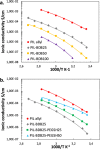Healable Ionoelastomer Designed from Polymeric Ionic Liquid and Vitrimer Chemistry
- PMID: 36686061
- PMCID: PMC9844214
- DOI: 10.1021/acsapm.2c01635
Healable Ionoelastomer Designed from Polymeric Ionic Liquid and Vitrimer Chemistry
Abstract
The growing demand for all-solid flexible, stretchable, and wearable devices has boosted the need for liquid-free and stretchable ionoelastomers. These ionic conducting materials are subjected to repeated deformations during functioning, making them susceptible to damage. Thus, imparting cross-linked materials with healing ability seems particularly promising to improve their durability. Here, a polymeric ionic liquid (PIL) bearing allyl functional groups was synthesized based on the quaternization of N-allylimidazole with a copolymer rubber of poly(epichlorohydrin) and poly(ethylene oxide) (PEO). The resulting PIL was then cross-linked with dynamic boronic ester cross-linkers 2,2'-(1,4-Phenylene)-bis[4-mercaptan-1,3,2-dioxaborolane] (BDB) through thiol-ene "click" photoaddition. PEO dangling chains were additionally introduced for acting as free volume enhancers. The properties of the resulting all-solid PIL networks were investigated by tuning dynamic cross-linkers and dangling chain contents. Adjusting the cross-linker and dangling chain quantities yielded soft (0.2 MPa), stretchable (300%), and highly conducting ionoelastomers (1.6 × 10-5 S·cm-1 at 30 °C). The associative exchange reaction between BDB endowed these materials with vitrimer properties such as healing and recyclability. The recycled materials were able to retain their original mechanical properties and ionic conductivity. These healable PIL networks display a great potential for applications requiring solid electrolytes with high ionic conductivity, healing ability, and reprocessability.
© 2022 The Authors. Published by American Chemical Society.
Conflict of interest statement
The authors declare no competing financial interest.
Figures






References
LinkOut - more resources
Full Text Sources
Miscellaneous

